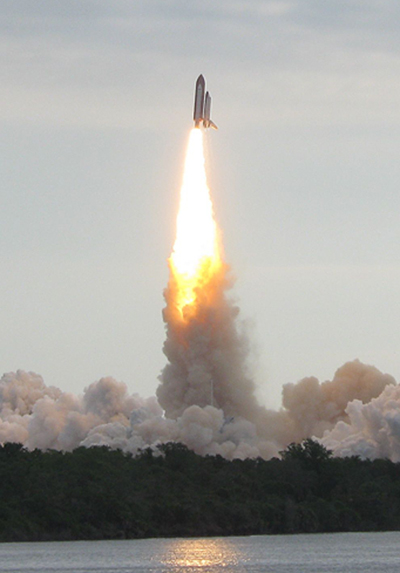Not often am I up looking at sights in the early morning sky. But this morning was a notable exception. Not only did I get to see a gorgeous Moon and two bright planets, it was launch time for Space Shuttle Endeavour.
At 3 a.m. my husband, Mark, and I arrived at the Kennedy Space Center to witness and photograph "astronaut walkout." That's the now-iconic scene, soon to fade into American history, where the astronauts come out to board their silver trailer to the launch pad. They were greeted by clapping and cheering from camera-laden members of the press. Commander Mark Kelly, pilot Gregory H. Johnson, and crew members Michael Fincke, Greg Chamitoff, Andrew Feustel, and Roberto Vittori waved back at us, then took off in the astronaut-mobile under the gaze of that almost-full Moon.
It was time for the next act in the ritual: the wait for launch. We headed over to the countdown clock to set up our camera and video gear, along with the other several hundred members of the news media here at the Kennedy Space Center press site. We were greeted by a glorious view of the shuttle and its support structure lit by floodlights. As I scanned the sky with my camera, there were Venus and Jupiter low in the east. I'm not a believer in lucky omens, but those gorgeous planets seemed like a good sign — that this launch, delayed in April first by a scheduling change and then a technical problem — was good to go.
About half an hour after the astronauts were strapped into Endeavour, a filmmaker next to me who was glued to the screen of her smartphone laughed and said, "Hey, the astronauts are tweeting from the orbiter!" And sure enough, little electronic greetings were streaming out via Twitter, reassuring us from the flight deck that all was going well.
The rising Sun lit up a clear sky in the east, but clouds loomed in the west. Everybody became quiet and nervous. Would weather force yet another launch scrub? T-38 chase planes did touch-and-gos at the landing site, and the weather plane sniffed around the clouds to see how thick they were. At last word came down: NASA's weather reports were cheerful. "No scrub. Everything's still 'go' for launch." The planets had disappeared into the sunshine, but they were still a good sign.

Endeavour lifts off on its final mission to the International Space Station on May 16, 2011. This is the next-to-last shuttle launch for NASA.
Carolyn Collins Petersen
Finally, the countdown crossed the T-minus-2-minute mark and we knew this one was going up. Everybody turned on cameras and recorders.
With a blast of sound and brilliant white exhaust, Endeavour lifted off at 8:59 a.m. on its final, 16-day mission to the International Space Station (ISS). It quickly disappeared into the low-lying clouds. But we could still hear it — and feel it — as the sound from the rocket boosters washed over us in waves. Watch a video of the launch by contributor Chris Hetlage here
The main goals of this mission are to deliver the Alpha Magnetic Spectrometer particle-physics experiment, spare antennas, a set of parts for the station's Dextre telemanipulator robot, a high-pressure gas tank, and an updated navigation system. Team members will perform four spacewalks.
What I find especially interesting about this launch is, even though it's the last for Endeavour and the next-to-last for the shuttle program, it contains the seeds of NASA's future. Some of the work being done by the shuttle crew and ISS astronauts during this mission lays groundwork for the next generation of flights to the ISS. During this mission, teams in orbit and on the ground will test and demonstrate a state-of-the-art navigation system called the "Sensor Test for Orion Relative Navigation Risk Mitigation", or STORRM. It's a leap forward that you can read more about at NASA's STORRM website. (Video is here.)
One of the reporters here asked me how I felt about this final Endeavour mission. I thought back to the first time I saw it launch, on the first Hubble servicing mission back in December 1993. I was still in graduate school and working on one of Hubble's instrument teams. It was a very early morning launch (4:26 a.m) and one of the most beautiful I had ever seen. I remember standing here at the press site, looking out at the starry night that was soon to be lit bright by the launch. Then as now, I looked out over the lagoon behind the countdown clock to see Jupiter rising low in the east. A good sign? You bet! And I felt pretty good about that one, too.
This mission is STS 134, the 134th in the shuttle program. You can follow its progress on NASA's shuttle program's website.
 0
0
Comments
You must be logged in to post a comment.